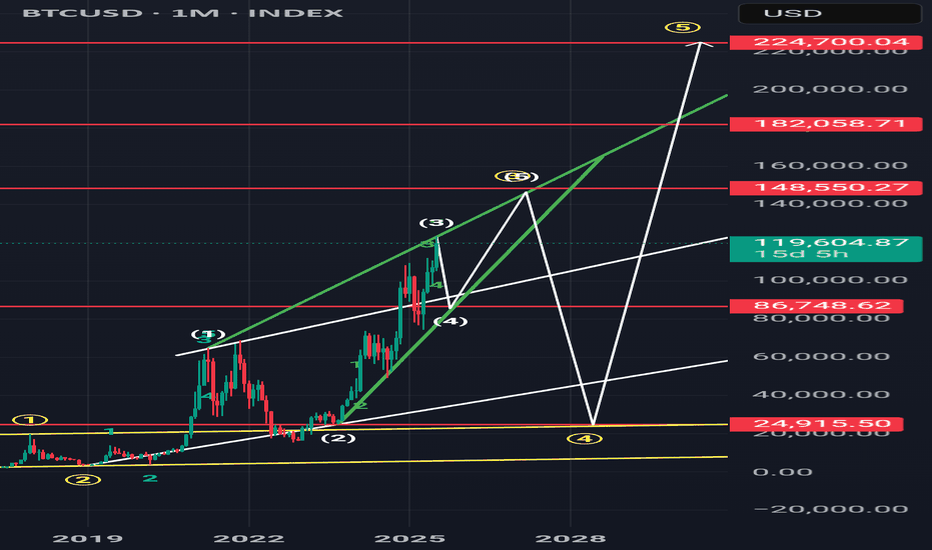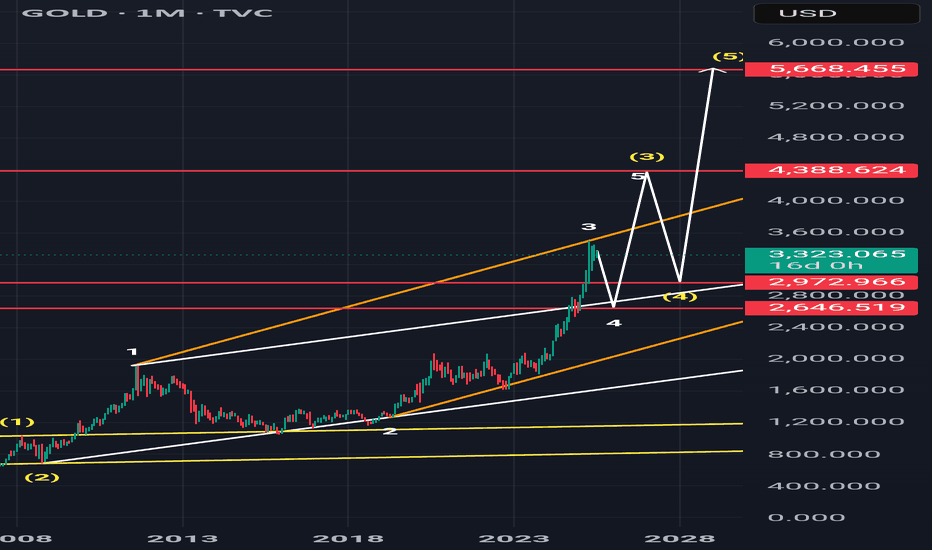Wave4
Gold Elliott Wave Outlook: Possible Wave 4 CorrectionGold Elliott Wave Analysis: Potential Wave 4 Correction Toward $3,650
The price of gold (XAU/USD) has recently shown signs of completing its third Elliott wave around the $3,720 region. According to Elliott Wave analysis for gold, this level may have marked the peak of Wave 3, and the market could now be setting up for a Wave 4 correction. The minimum retracement target for this corrective move appears to be in the $3,650 support zone. However, the ascending trendline remains intact, which means entering a short position prematurely—before a decisive break of the trendline—still carries significant risk.
Elliott Wave Perspective
In Elliott Wave theory, Wave 4 typically represents a corrective phase following the strong impulsive move of Wave 3. These corrections often retrace into previously consolidated zones, creating a buying opportunity before Wave 5 emerges. In this case, the highlighted box around $3,650 represents the most probable demand zone where buyers could step back in.
The critical factors to watch on the chart are:
Whether gold can hold above the rising green trendline. A confirmed breakdown would significantly increase bearish momentum.
If gold fails to reclaim and sustain the $3,720 level, sellers may gain confidence and push prices lower.
The $3,650 area is both a psychological and technical support, making it an ideal candidate for the bottom of Wave 4.
Keywords for SEO: gold Elliott Wave analysis, wave 4 correction, gold price forecast, gold support zone, XAUUSD technical outlook, gold bearish scenario, gold trading strategy
Fundamental Catalysts Supporting a Bearish Outlook
While technical analysis suggests a potential drop, fundamentals also align with the possibility of a correction in gold prices. Several macroeconomic and market factors could act as catalysts for a decline from $3,720 toward $3,650.
Stronger U.S. Economic Data
Recent data releases from the United States have shown resilience in the economy. Stronger-than-expected GDP growth or consumer spending could push the Federal Reserve to maintain higher interest rates for longer. This hawkish outlook would support the U.S. dollar, making gold less attractive as a non-yielding asset.
Rising Real Yields
Gold has no yield, so its attractiveness declines when real interest rates rise. If U.S. Treasury yields continue to move higher while inflation expectations remain anchored, real yields will climb. This environment historically creates downward pressure on gold.
Strength in the U.S. Dollar
The U.S. dollar index (DXY) has been consolidating near higher levels. A renewed surge in the dollar would make gold more expensive for foreign buyers, limiting demand and contributing to downside pressure.
Weak Physical Demand from Asia
Physical demand from key gold-buying nations like China and India remains a major factor. Recent reports indicate that China’s gold imports via Hong Kong fell by nearly 39% compared to the previous month, signaling weakening appetite. This reduction in demand could remove an important support pillar for gold prices.
ETF Outflows and Reduced Speculative Interest
Gold ETFs and futures often amplify momentum. If speculative capital continues to exit the market, price declines could accelerate.
Diminished Geopolitical Tensions
Gold acts as a safe-haven asset during crises. However, if global geopolitical risks or inflation fears ease, investor demand for gold could wane, further validating a correction.
Trading Strategy and Risk Management
The current technical setup suggests caution. While the Elliott Wave pattern points toward a corrective move, timing the entry is crucial:
A break below the green uptrend line would confirm bearish momentum and increase the probability of a decline toward $3,650.
Aggressive traders may attempt to short below $3,720 resistance, but conservative traders may prefer waiting for a clean break and retest of the trendline.
Risk management remains essential, as failure of the bearish scenario could lead to a renewed rally above $3,800.
Conclusion: Gold Outlook for Traders
Combining Elliott Wave theory with fundamental drivers, gold appears vulnerable to a Wave 4 correction. A break of the rising trendline could accelerate selling pressure, with a minimum downside target of $3,650. Strong U.S. economic data, rising real yields, weaker physical demand from China, and strength in the U.S. dollar all support this bearish outlook.
Still, traders should remain flexible. Gold remains a safe-haven asset, and renewed geopolitical tensions or dovish central bank commentary could quickly reverse the bearish narrative. For now, monitoring the $3,720 resistance and the green uptrend line will be essential to confirm whether the next move is indeed a correction or just a consolidation before another rally.
Elliot waves meets Fibonacci [Educational]Hello everyone,
today I like to share how I use elliot waves combined with fibonacci to analyze the market.
The standard rules are:
- Wave 2 can now be lower then the start of wave 1
- Wave 3 should be the longest
- Wave 4 should not breach the high of wave 1
But to have a more objective view there are also price targets to be reached within the different waves. It's a complex subject to show in one chart, so feel free to ask in the comment section if you have any questions.
Dixon Technologies Share Price Movements with Wave TheorySynopsis of Dixon Technologies Share Price Movements with Wave Theory Correlation
The share price of Dixon Technologies has demonstrated significant fluctuations and growth over the past few years, aligning with the principles of Elliott Wave Theory. This theory suggests that market prices move in predictable wave patterns, typically consisting of five major waves followed by three corrective waves.
Miner Waves Analysis
Wave 1: Date: February 2020, Price: ₹919.45
Description : This initial upward movement marks the beginning of the bullish trend.
Wave 2: Date: March 2020, Price: ₹678.25
Description : A correction phase that follows the first wave, typically retracing a portion of Wave 1's gains.
Wave 3: Date: March 2021, Price: ₹4267.25
Description : Often the strongest and longest wave in the Elliott Wave sequence, Wave 3 represents a significant upward move.
Wave 4: Date: August 2021, Price: ₹4046.25
Description : Another corrective phase, Wave 4, generally retraces less than Wave 2. The target for Wave 4 typically aims to correct 38.2% to 50% of Wave 3, which aligns with the observed price movement.
Wave 5: Date: October 2021, Price: ₹5112.05
Description : The final wave in the primary bullish trend, Wave 5, usually completes the uptrend before a larger corrective phase begins.
Intermediate Waves Analysis
Intermediate Wave (1): Date: October 2021, Price: ₹5112.05
Description : This wave mirrors the final leg of the miner waves, marking the beginning of a new, larger wave cycle.
Intermediate Wave (2): Date: January 2023, Price: ₹2553
Description: A substantial correction that aligns with the typical Wave 2 pattern, correcting a significant portion of Wave (1).
Intermediate Wave (3): Date: July 2024, Price: ₹12879
Description : Following the principles of Elliott Wave Theory, Wave (3) in the intermediate cycle is expected to be the most powerful, reflecting a strong upward movement.
Intermediate Wave (4) Target: Target Price: ₹8900-₹9000
Description : Based on Elliott Wave Theory, Intermediate Wave (4) is projected to correct approximately 38.2% of Wave (3), targeting a price range of ₹8900-₹9000.
Conclusion
The share price movements of Dixon Technologies from February 2020 to July 2024 align well with Elliott Wave Theory. The price started at ₹919.45 and went through a series of upward and corrective waves, reflecting typical wave patterns. The miner waves demonstrated an initial uptrend followed by corrections, culminating in a peak at ₹5112.05. Subsequently, the intermediate waves exhibited a similar pattern, with a substantial correction followed by a strong upward wave, reaching ₹12879 in July 2024. The target for Intermediate Wave (4) is projected to be in the range of ₹8900-₹9000, based on a 38.2% retracement of Wave (3). This analysis confirms the applicability of wave theory to Dixon Technologies' share price movements, indicating predictable patterns in market behavior.
Disclaimer
It's important to note that investing in shares involves risks, and past performance is not indicative of future results. The information provided here is based on technical analysis and Elliott Wave Theory, which are tools used to analyze market trends but do not guarantee future outcomes. Investors should conduct their own research or consult with a financial advisor before making investment decisions.






















